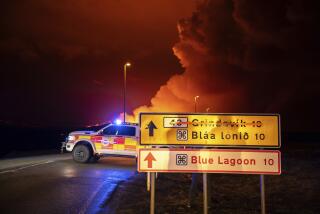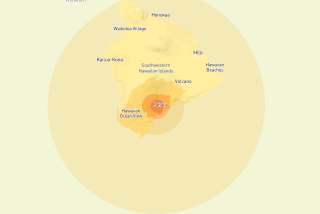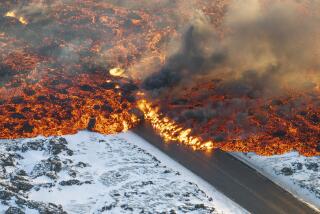In Hawaii, village residents prepare to evacuate as lava approaches
Since Kilauea turned toward this historic rural Big Island village on June 27, residents and business owners have feared lava could flow through their streets. That day is approaching fast.
Early Saturday, lava made its way through the uninhabited rainforest and crossed Apa’a Road on the outskirts of town, threatening 50 to 60 buildings. By Sunday afternoon, lava had flowed through a cemetery.
Kilauea has been erupting for 31 years, but a new vent opened in June. That vent is threatening Pahoa, about 20 miles southwest of Hilo.
The flow front is 35 feet wide and moving at 10 yards per hour. If it continues at that speed it could cross Pahoa Village Road, the town’s main street, within the next few days. From there it could cover Highway 130 within a week or two.
Although two unpaved escape roads have been built, and another more permanent road is under construction, if lava crosses the only highway in the lower Puna district, it would largely isolate the 9,000 people who live there.
Hawaii County Civil Defense Director Darryl Oliveira issued a preliminary evacuation notice Saturday for the first 40 or 50 residents nearest the front of the flow. People should be prepared to evacuate by Tuesday if conditions warrant, he said.
“The current timelines are based on the current flow rates, and that could change. That could speed things up, as well as it could slow things down,” Oliveira said. “The key is that we will be watching the flow 24/7.”
Civil Defense Community Response Team volunteers are going door to door to keep residents informed.
As of Sunday afternoon, the closest occupied home was 300 yards from the flow front.
Lava flows at 2,000 degrees Fahrenheit, hot enough to melt or burn everything in its path — including utility poles. Scientists from the Hawaii Volcanoes Observatory and the University of Hawaii Department of Geology, working with the Hawaii Electric Light Co., have developed an experimental strategy to keep the power on.
Power poles in the lava’s path are wrapped in thick insulating foil. Then an 18-foot-high ring of cattle fencing is placed around each pole and filled with crushed rock and cinders. Although the ongoing lava flow may eventually reach higher than 18 feet, thus far these “super telephone poles” are intact and utility services have not been interrupted.
“We are encouraged by the initial result of the pole protection design,” power company spokeswoman Rhea Lee said. “But the long-term results are still not determined. As the lava flow progresses, we expect the lava will rise and inflate. This is the second test of our experimental design.”
The initial design of the poles was submitted to the power company by students at the Hawaii Academy of Arts and Sciences, the local public charter school that may have to relocate if the lava continues to advance.
“We really applaud their efforts and their design. This is the future of engineering,” Lee said.
Oliveira points out that, unlike other natural disasters such as a hurricane or tsunami, the inexorable, slow-moving lava allows ample time to set up shelters and other services for those affected.
Some residents have already moved away, or made arrangements to stay with family or friends. Portable classrooms are being built about 10 miles to the northeast at Kea’au High School, to serve Pahoa students if necessary. At least one church has opened its doors as an evacuation center.
In the face of the impending disaster, the mood on the streets of Pahoa is one of calm, resignation and resolve.
“I’m not planning to leave until the lava reaches right about here,” said Alfred Lee, pointing to the ground in front of his Apa’a Street house. “It’s gonna come sooner or later.”
His neighbor on the lava flow’s front lines, Robert Shioshita, agrees. “I know how the other people feel because I’m in it this time. No can do nothing. It hurts, but it’s Pele’s land and she’s reclaiming,” he said, referring to the Hawaiian deity of the volcano.
Downtown Pahoa consists of a few blocks of independently owned businesses: health food stores, surf shops, clothing boutiques, holistic medical practitioners, smoke shops and restaurants. Dave Ewing, co-owner of the Sirius Hotspot Coffee Shop, said he would stay open as long as he could and reopen as quickly as possible if he was forced to close.
“We want to keep the spirit of Pahoa,” he said. “The viability of the town will remain. A flow field here will just add another aspect to an already unique town.”
More to Read
Start your day right
Sign up for Essential California for news, features and recommendations from the L.A. Times and beyond in your inbox six days a week.
You may occasionally receive promotional content from the Los Angeles Times.






